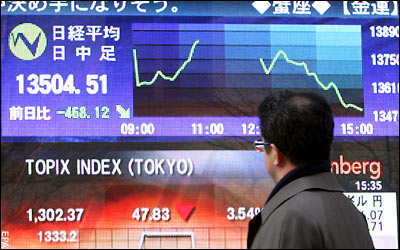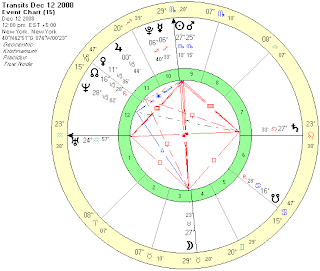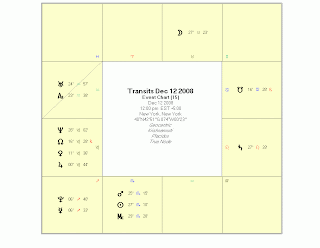
(Updated April 15, 2009) To say a lot has happened in the economy since my last update in September is an understatement. Stocks markets crashed in the fall more or less as predicted as the global economy worsened as credit was strangled by an increasingly embattled banking sector. While the new Obama administration has put in place a wide range of programs designed to encourage lending and generate economic activity, unemployment is still rising.
The stock market has strongly rallied off its early March lows as optimism is growing that the worst is over with the prospect of recovery later in 2009 and 2010. Certainly, India and China appear to have better prospects and their stock markets have fared better than markets in North America and Europe. And while the recent rally has been quite strong — 25% in one month — it seems to have come too far, too fast. Part of the rally can be attributed to the approaching conjunction of Jupiter and Neptune in June. Jupiter symbolizes confidence, expansion and opportunity while Neptune can signify ideals and perfection. After some second guessing that may occur this spring, there is a possibility for an exaggerated sense of optimism over the summer as we may see a series of favourable economic data that point to a quick recovery. And yet the Saturn-Pluto square in the fall 2009 indicates that the optimistic air may go out of the Jupiter-Neptune balloon pretty fast. Back in June 2008, I thought we might see the Dow under 7000 by December and that still looks to be a possible scenario.
With the Saturn-Uranus-Pluto alignment in force for much of 2010, it’s hard to see the economy really improving much before 2011. That means that markets will be hard pressed to move higher and will likely move lower still. And even if Saturn moves out of range of this stressful alignment by 2011, Uranus and Pluto will still be in aspect will into 2012. These longer term alignments will allow for short stock rallies, but they make it harder for the economy to really shake off the lethargy and get on solid footing again.
So we may not see the US economy recover for several years yet and the markets may similarly disappoint those who are hopeful of a quick return to a bull market. From a general perspective, I think it is very possible that we will see the Dow trade below 4000 at some point over the next two years.
(Updated September 4, 2008) As stocks once again have failed to rally to 12,000 on the Dow, it seems clear that the market is heading down from here. In my previous post in this section, I had thought that the bulk of the decline would occur in November and December. While it’s likely that these months will still be bearish for the market, I think the decline may already have begun. The Dow lost 3% today and the next two weeks look quite negative astrologically particularly from September 12 – 15. A breach of the 10,500 support level on the Dow is very likely here and would set up a protracted decline over the next three months. 7500 is still a possible target as the credit crunch works through the financial system.

(Posted June 26, 2008) This recent decline in global markets has all the earmarks of a new bear market. If the market is heading lower here, then one has to wonder how long this pessimism will last. While I have been bearish for over a year now, I have never really given the length of bear market much thought. Certainly, there are good theoretical reasons for thinking that this is no ordinary, run-of-the-mill bear market. The bull market that preceded it was unprecedented in terms of its length (18 years) and the increase in stock values (over 1500%). While there is no law that bear markets are always proportional to the bull markets that precede them, it is not unreasonable to assume that there is some correlation there. The bear market of the 1930s followed the extended bull run of the 1920s, while the decline of the 1970s was part of a longer sequence that began with the bull market in the 1950s and early 1960s. Besides the extent of the previous rise on the market, we also are faced with the prospect of a new reality in the energy sector. Crude oil is setting record levels and there is no end in sight as supplies are increasingly seen as finite while the developing world in Asia is experiencing the most rapid economic growth in its history which will push demand to ever-higher levels. To add to this unstable economic mix, the US economy is in a precarious state as government and personal debt levels are growing faster than ever before, as the US dollar falls to new modern day lows against most currencies. Even without any astrological insight, it does seem we’ve moved into a dangerous new economic era in which stock markets are unlikely to do well.
But we know that the planetary patterns are also indicative of prolonged difficulties in the economy. As Louise McWhirter discovered, Rahu transiting through tropical Aquarius/sidereal Capricorn has a very negative effect on the US economy and is usually associated with recessions. Outer planets in hard aspect also often signal global problems that have financial manifestations. The depth of depression in 1932 was marked by the t-square between Saturn, Uranus and Pluto. In a 2005 article in The Mountain Astrologer, Ray Merriman has noted that a t-square involving the same planets will occur in 2010 and has suggested we may be in for a similarly negative economic downturn. While I do think this t-square will mark the likely bottom in the stock market, I’m not sure it will be as bad as the 1930s where stocks lost over 85% of their value from their 1929 highs. This is because these planets will not conjoin on or near any key planets in the NYSE chart. In 1932, transiting Uranus conjoined the natal Moon of the NYSE 1792 chart while Pluto formed an exact square to it. These closer natal afflictions were perhaps additional sources of bearish sentiment that forced stocks down to those historic levels.
We are likely to see a steep decline in stocks in November and December as Saturn stations opposite Uranus. This is a difficult configuration in mundane affairs, but since Saturn will station on the natal 2nd house Mars in the NYSE chart, there is good reason to think it may have a directly negative effect on the market. Assuming we see new lows set in July around 10,500-11,000 on the Dow, any rallies after that into the Fall may get the market back as high as 12,000-12,500. I think I’m being generous there, but it is possible. This is the classic pattern of a bear market rally where significant gains of 20% or more can occur in a few months. The key point here is that the highs are not as high as the previous ones. The market then loses faith and starts a new leg down towards a new lower low. This is what is likely to occur in November and December. I would not be surprised to see the Dow go down to 8500-9000 at that time. This may correspond to about 10,000 -11,000 on the Bombay Stock Exchange. After that, we can expect to see some sideways movement and perhaps another rally at some point in 2009, especially in May and June as Jupiter will station at 2 degrees of Aquarius conjunct the natal Pluto in the NYSE chart. Neptune will be there also for good measure, adding to the deluded quality of the rally. Again, the highs likely won’t equal where we are now or even where the market might reach in Fall 2008 — perhaps 11,000-11,500 on the Dow is possible then. But the Fall 2009 period looks terrible for the markets again as Saturn stations as 10 Virgo exactly conjunct the natal Rahu in the NYSE chart. To make matters worse, this will be square Pluto within just a few minutes of orb. To add to the general sense of volatility and chaos, transiting Ketu will be aspecting transiting Uranus within a degree and in December 2009 transiting Mars will station just degree from the natal Uranus in the NYSE chart. This confluence of negative factors might suggest a low point in the market, perhaps in the 6000-7000 range. Calling market lows so far in the future is pure speculation but I do think that the declines will be on that order of magnitude, i.e. 50% or more off the all-time highs of 14,000 on the Dow.



